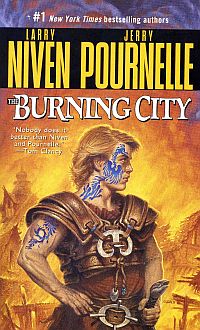Larry Niven & Jerry Pournelle, The Burning City
reviewed by Danielle L. Parker

|
|
The Burning City
Author: Larry Niven & Jerry PournellePublisher: Pocket Books, 2001 Length: 640 pages ISBN: 0671036610 |
The partnership seems to work. The Burning City is the pre-history saga of Whandall Feathersnake, set in a time when gods and myths are still real — or real problems, I should say. The burning god Yagen-Atep periodically incites the inhabitants of Tep’s Town to destructive orgies of burning and looting. Morth, the fugitive Atlantean wizard, fears a vengeful water-sprite (Atlantis here is humorously depicted not as the victim of a just retribution but of a do-good social experiment gone awry). ‘Wild gold’ induces madness and power in those who touch it, a myth echoed in Teutonic folklore and Wagner’s Ring cycle. The prankster god and storyteller Coyote makes a typically mischievous appearance. Plants and animals mellowed in our time fight back — and kill — in this distant pre-history. Humanity itself is divided into clear predator vs. prey classes, from the Lords and Lordkins to the worker ants of the social pyramid, the kinless.
Whandall is born in the Placehold among the Lordkins of Tep’s Town. It’s not an easy birth (or berth). Like the gangs of our time, the Lordkins jostle for position and status among themselves while preying on the lower classes. The boy Whandall, wandering too far from his home turf, learns the painful cost of antagonizing both Lords and Lordkins.
It’s fortunate that Whandall learns from his hard knocks, because when the periodic god-incited burning sweeps Tep’s Town once more, the Placehold does not fare well. Whandall is one of the few adults left alive to lead his kin. He’s learned guile and cunning in his weaker years, as well as enough pragmatism to work with the man who killed his father -- Morth the Atlantean. Placehold holds until the last fatal Burning, when Morth and Whandall are forced to leave Tep’s Town for an unknown world outside until they can return to Tep’s Town one last time.
I enjoyed the first part of this story the most. There, Niven and Pournelle impart Whandall’s strange society deftly and with great originality. Later parts of the story, as Whandall marries, begets children, and rises to wealth and prominence among the wandering traders and caravans, have a ‘Saga of The Great Man’ feel. Nor is the description of the caravan society — very American Indian — as gripping as the depictions of Tep’s Town and its rival gangs. We see more intrusive references to our time (Coyote the Trickster god, for example). Midway through the book, I began counting such ah-ha! references for the same reason my sister and I counted sightings of Volkswagen Beetles on long car trips — my attention wandered.
Still, the story wraps up with a resounding finish as Morth and Whandall return once more to Tep’s Town. I closed the book with the sense of time mostly well-spent. Whandall and I traveled a lot of pages together — 640, to be exact — but the old man was worth knowing. Enjoy!
Copyright © 2007 by Danielle L. Parker
See also Jerry Wright’s review of Larry Niven & Jerry Pournelle, Burning Tower in issue 229.

